light Acura RL 2000 3.5 Owner's Manual
[x] Cancel search | Manufacturer: ACURA, Model Year: 2000, Model line: RL, Model: Acura RL 2000Pages: 330, PDF Size: 4.53 MB
Page 265 of 330

Exterio
r Car e
Washin g
Frequent washing helps preserve
your car's beauty. Dirt and grit can scratch the paint, while tree sap and
bird droppings can permanently ruin the finish.
Wash your car in a shady area, not in direct sunlight. If the car is parked in
the sun, move it into the shade and
let the exterior cool down before you start.
Only use the solvents and cleaners
recommended in this Owner's
Manual.
Chemical solvents and strong cleaners
can damage the paint, metal, and
plastic on your car.
Rinse the car thoroughly with cool
water to remove loose dirt. Fill a bucket with cool water. Mix
in a mild detergent, such as
dishwashing liquid or a product
made especially for car washing. Wash the car using the water and
detergent solution and a soft-
bristle brush, sponge, or soft cloth. Start at the top and work your waydown. Rinse frequently. Check the body for road tar, tree
sap, etc. Remove these stains with
tar remover or turpentine. Rinse it off immediately so it does not
harm the finish. Remember to re-
wax these areas, even if the rest of
the car does not need waxing. When you have washed and rinsed
the whole exterior, dry it with achamois or soft towel. Letting it
air-dry will cause dulling and water
spots.
As you dry the car, inspect it for chips and scratches that could allow
corrosion to start. Repair them with
touch-up paint (see page 263 ).
Appearanc e Car e
NOTIC
E
Page 266 of 330

Exterio
r Car e
Waxin g
Always wash and dry the whole car before waxing it. You should wax
your car, including the metal trim,
whenever water sits on the surface in large patches. It should form into
beads or droplets after waxing .
You shoul
d use a quality liquid or
paste wax. Apply it according to the
instructions on the container. In
general, there are two types of
products:
Waxes — A wax coats the finish and protects it from damage by exposure
to sunlight, air pollution, etc. Youshould use a wax on your Acura
when it is new.
Polishes — Polishes and cleaner/
waxes can restore the shine to paint
that has oxidized and lost some of its shine. They normally contain mild
abrasives and solvents that remove
the top layer of the finish. You should use a polish on your Acura if
the finish does not have its original shine after using a wax.
Cleaning tar, insects, etc. with
removers also takes off the wax.
Remember to re-wax those areas,
even if the rest of the car does not
need waxing.
Aluminu m Wheel s
Clean your Acura's aluminum alloy
wheels as you do the rest of the exterior. Wash them with the samesolution, and rinse them thoroughly.
The wheels have a protective clear- coat that keeps the aluminum from
corroding and tarnishing. Using
harsh chemicals, including some commercial wheel cleaners, or stiff
brushes can damage this clear-coat. Only use a mild detergent and soft
brush or sponge to clean the wheels.
Pain
t Touch-u p
Your dealer has touch-up paint to match your vehicle's color. The color
code is printed on a sticker on the
driver's doorjamb. Take this code to
your dealer so you are sure to get the correct color.
Inspect your car frequently for chips
or scratches in the paint. Repair
them right away to prevent corrosion of the metal underneath. Use the
touch-up paint only on small chips
and scratches. More extensive paint damage should be repaired by a
professional.
Appearance Car e
Page 274 of 330
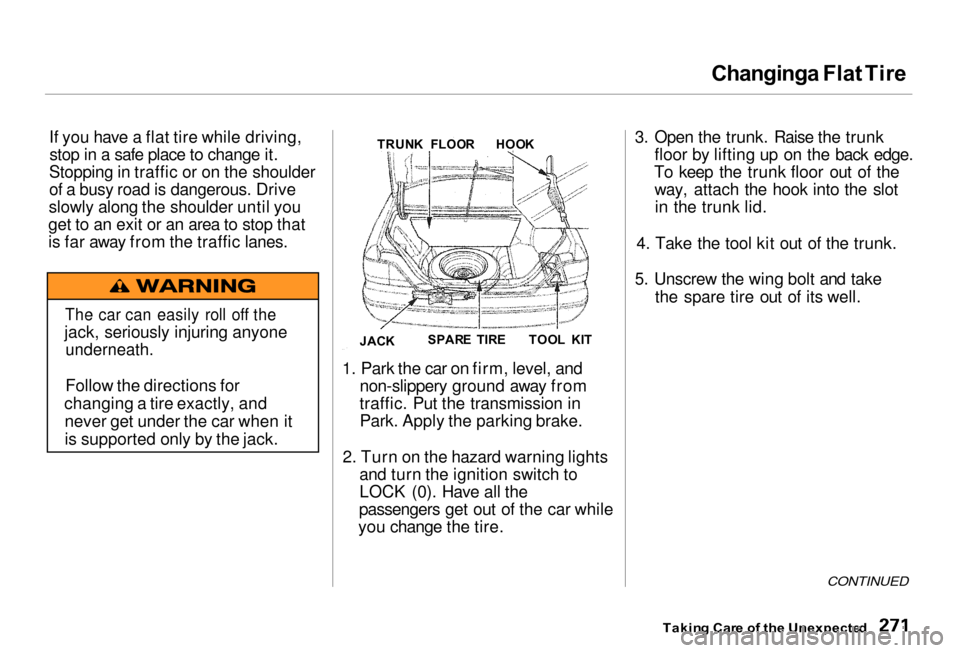
Changing
a Flat Tir e
If you have a flat tire while driving, stop in a safe place to change it.
Stopping in traffic or on the shoulder
of a busy road is dangerous. Drive
slowly along the shoulder until you
get to an exit or an area to stop that
is far away from the traffic lanes.
1. Park the car on firm, level, andnon-slippery ground away from
traffic. Put the transmission in Park. Apply the parking brake.
2. Turn on the hazard warning lights and turn the ignition switch to
LOCK (0). Have all the
passengers get out of the car while
you change the tire. 3. Open the trunk. Raise the trunk
floor by lifting up on the back edge.
To keep the trunk floor out of the way, attach the hook into the slotin the trunk lid.
4. Take the tool kit out of the trunk.
5. Unscrew the wing bolt and take the spare tire out of its well.
CONTINUED
Takin g Car e o f th e Unexpecte d
The car can easily roll off the
jack, seriously injuring anyone
underneath.
Follow the directions for
changing a tire exactly, and never get under the car when it
is supported only by the jack. TRUN
K FLOO R
HOO K
TOO L KI T
SPAR E TIR E
JAC K
Page 280 of 330
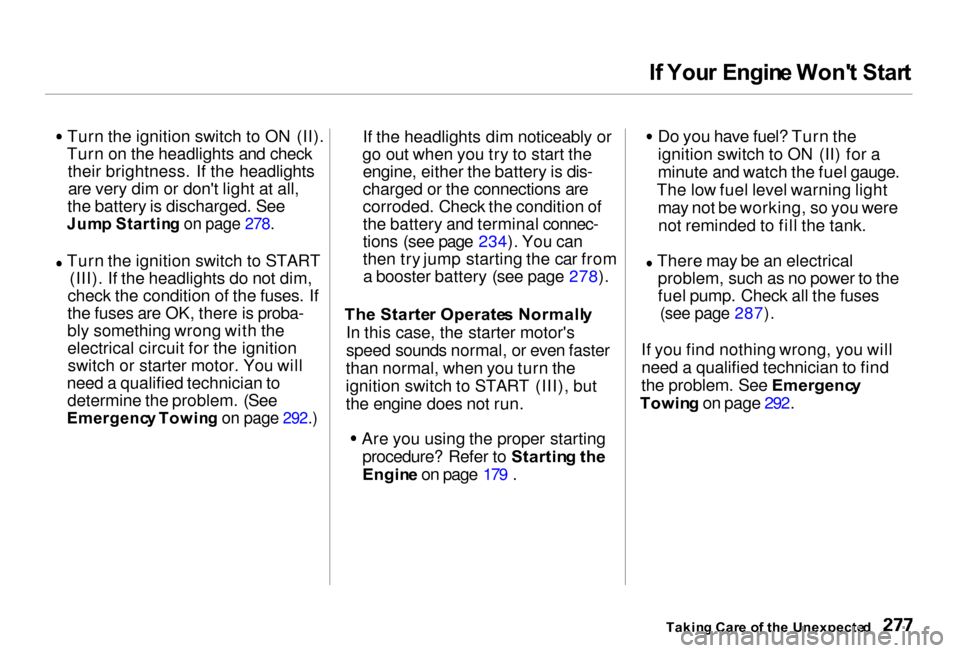
I
f You r Engin e Won' t Star t
Turn the ignition switch to ON (II).
Turn on the headlights and check their brightness. If the headlightsare very dim or don't light at all,
the battery is discharged. See
Jum p Startin g on page 278.
Turn the ignition switch to START
(III). If the headlights do not dim,
check the condition of the fuses. If
the fuses are OK, there is proba-
bly something wrong with the
electrical circuit for the ignition switch or starter motor. You will
need a qualified technician to determine the problem. (See
Emergenc y Towin g on page 292.)
If the headlights dim noticeably or
go out when you try to start the engine, either the battery is dis-
charged or the connections are
corroded. Check the condition of
the battery and terminal connec-
tions (see page 234). You can
then try jump starting the car froma booster battery (see page 278 ).
Th e Starte r
Operate
s Normall y
In this case, the starter motor's
speed sounds normal, or even faster
than normal, when you turn the
ignition switch to START (III), but
the engine does not run. Are you using the proper starting
procedure? Refer to Startin g th e
Engin e on page 179 . Do you have fuel? Turn the
ignition switch to ON (II) for a
minute and watch the fuel gauge.
The low fuel level warning light may not be working, so you werenot reminded to fill the tank. There may be an electrical
problem, such as no power to the
fuel pump. Check all the fuses
(see page 287).
If you find nothing wrong, you will need a qualified technician to find
the problem. See Emergenc y
Towin g on page 292.
Takin g Car e o f th e Unexpecte d
Page 281 of 330
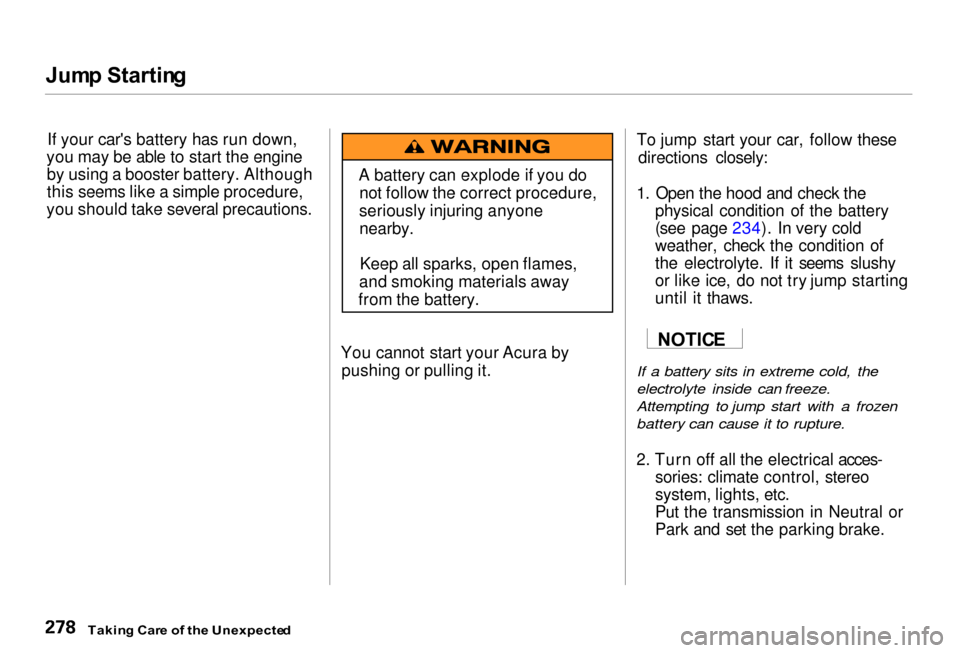
Jum
p Startin g
If your car's battery has run down,
you may be able to start the engine by using a booster battery. Although
this seems like a simple procedure,
you should take several precautions.
You cannot start your Acura bypushing or pulling it. To jump start your car, follow these
directions closely:
1. Open the hood and check the physical condition of the battery
(see page 234). In very cold
weather, check the condition of
the electrolyte. If it seems slushy
or like ice, do not try jump starting
until it thaws.
If a battery sits in extreme cold, the
electrolyte inside can freeze.
Attempting to jump start with a frozen
battery can cause it to rupture.
2. Turn off all the electrical acces- sories: climate control, stereo
system, lights, etc.
Put the transmission in Neutral or
Park and set the parking brake.
Takin g Car e
o
f th e Unexpecte d
A battery can explode if you do
not follow the correct procedure,
seriously injuring anyone nearby.
Keep all sparks, open flames,
and smoking materials away
from the battery.
NOTICE
Page 285 of 330
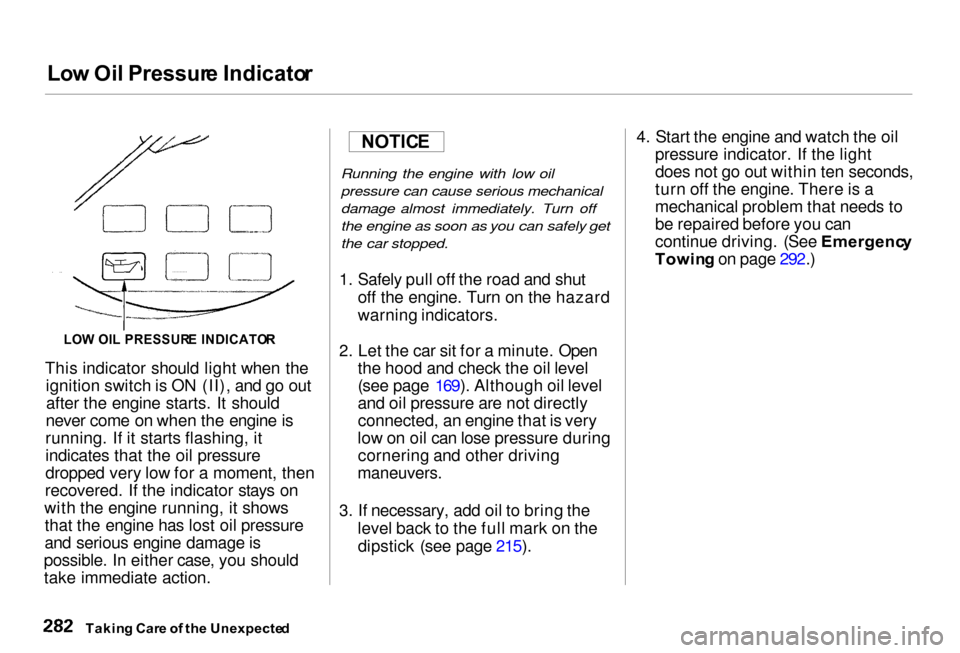
Lo
w Oi l Pressur e Indicato r
This indicator should light when the ignition switch is ON (II), and go outafter the engine starts. It should
never come on when the engine is
running. If it starts flashing, it
indicates that the oil pressure
dropped very low for a moment, then
recovered. If the indicator stays on
with the engine running, it shows that the engine has lost oil pressure
and serious engine damage is
possible
. I
n either case, you should
take immediate action.
Running the engine with low oil
pressure can cause serious mechanical
damage almost immediately. Turn off
the engine as soon as you can safely get
the car stopped.
1.
Safely pull off the road and shut
off the engine. Turn on the hazard
warning indicators.
2. Let the car sit for a minute. Open the hood and check the oil level
(see page
169). Although oil level
and oil pressure are not directly connected, a
n engine that is very
low on oil can lose pressure during cornering and other driving
maneuvers.
3. If necessary, add oil to bring the level back to the full mark on the
dipstick (see page
215). 4. Start the engine and watch the oil
pressure indicator. If the light
does not go out within ten seconds,
turn off the engine. There is a
mechanical problem that needs tob
e repaired before you can
continue driving. (See Emergenc y
Towin g o
n page 29
2.)
Takin g Car e
o
f th e Unexpecte d
NOTIC
E
LO W OI L PRESSUR E INDICATO R
Page 288 of 330
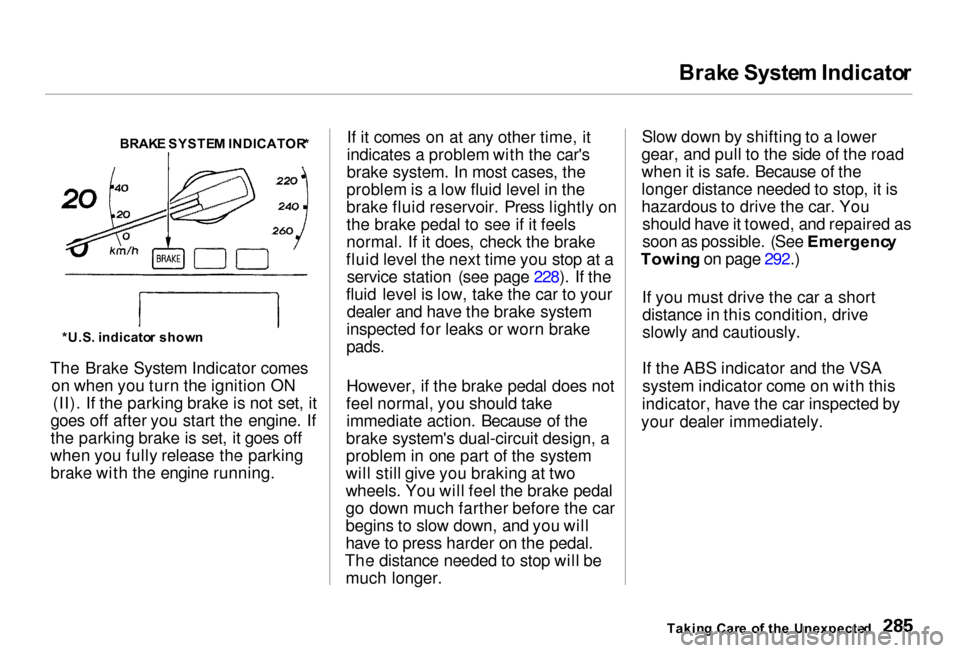
Brak
e Syste m Indicato r
The Brake System Indicator comes on when you turn the ignition ON (II). If the parking brake is not set, it
goes off after you start the engine. If
the parking brake is set, it goes off
when you fully release the parking brake with the engine running. If it comes on at any other time, it
indicates a problem with the car's
brake system. In most cases, the
problem is a low fluid level in the
brake fluid reservoir. Press lightly on
the brake pedal to see if it feels
normal. If it does, check the brake
fluid level the next time you stop at a service station (see page 228). If the
fluid level is low, take the car to your dealer and have the brake system
inspected for leaks or worn brake
pads.
However, if the brake pedal does not
feel normal, you should take immediate action. Because of the
brake system's dual-circuit design, a
problem in one part of the system
will still give you braking at two
wheels. You will feel the brake pedal
go down much farther before the car
begins to slow down, and you will
have to press harder on the pedal.
The distance needed to stop will be much longer. Slow down by shifting to a lower
gear, and pull to the side of the road
when it is safe. Because of the
longer distance needed to stop, it is
hazardous to drive the car. You should have it towed, and repaired as
soon as possible. (See Emergenc y
Towin g on page 292.)
If you must drive the car a short distance in this condition, drive
slowly and cautiously.
If the ABS indicator and the VSA system indicator come on with this
indicator, have the car inspected by
your dealer immediately.
Takin g Car e o f th e Unexpecte d
*U.S
. indicato r show n
BRAK
E SYSTE M INDICATOR *
Page 289 of 330
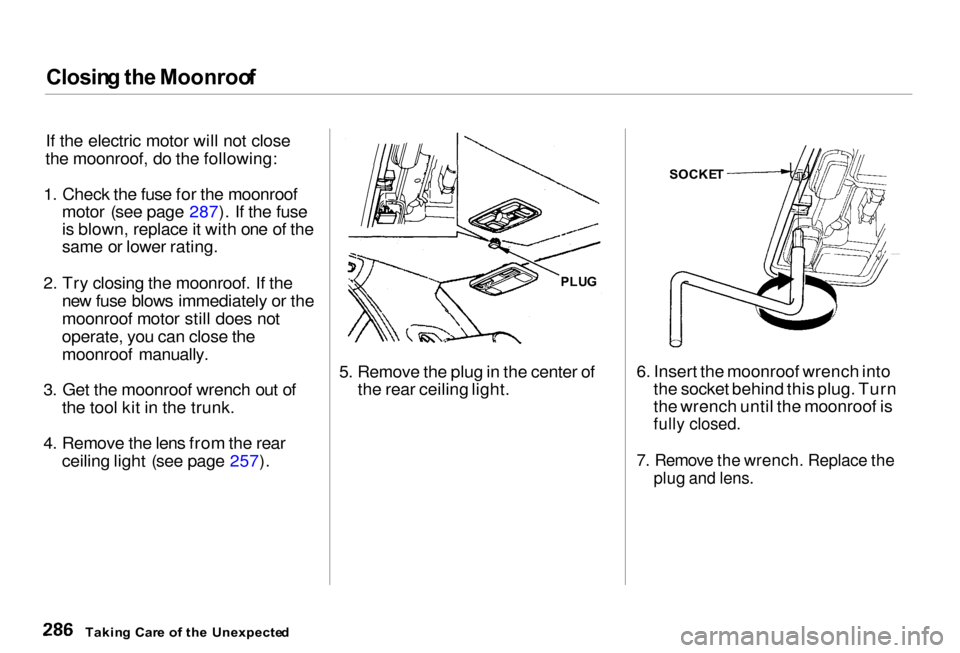
Closin
g th e Moonroo f
If the electric motor will not close
the moonroof, do the following:
1.
Check the
fuse for the moonroof
motor (see page
287). If the fuse
is blown,
replace it with one of the
same or lower rating.
2. Try closing the moonroof. If the new fuse blows immediately or the
moonroof motor still does not
operate,
you can close the
moonroof manually.
3. Get the
moonroof wrench out of
the tool kit in the trunk.
4. Remove the
lens from the rear
ceiling light (see page
257). 5. Remove the
plug in the center of
the rear ceiling light. 6. Insert the moonroof wrench into
the socket behind this plug. Turn
the wrench until the moonroof is
fully closed.
7. Remove the wrench. Replace the
plu
g and lens.
Takin g Car e
o
f th e Unexpecte d
PLU
G SOCKE
T
Page 291 of 330
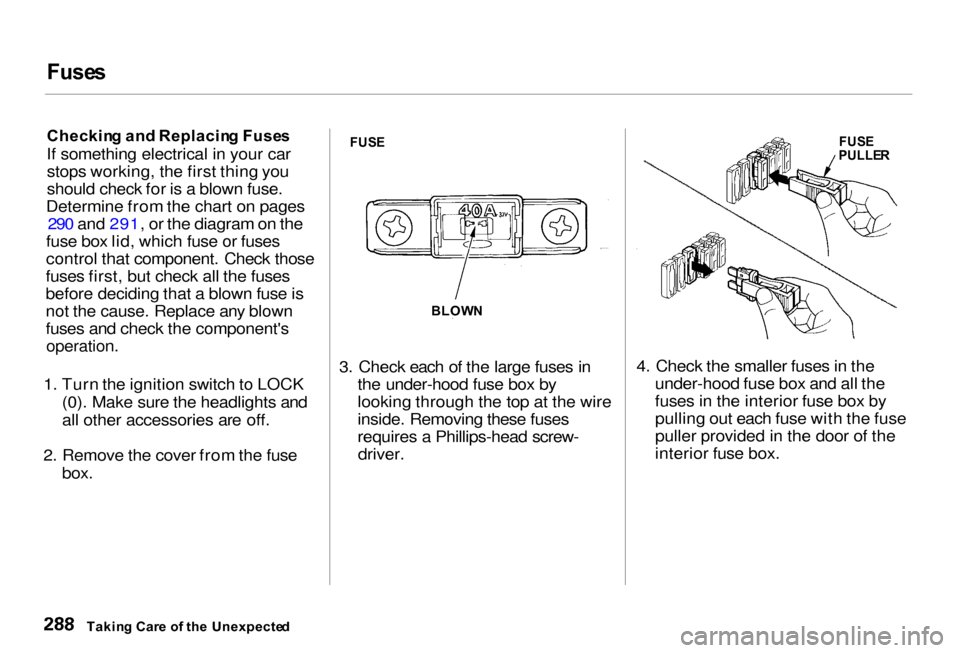
Fuse
s
Checkin g an d Replacin g Fuse s
If something electrical in your car stops working, the first thing you
should check for is a blown fuse.
Determine from the chart on pages 290 and 291, or the diagram on the
fuse box lid, which fuse or fuses
control that component. Check those
fuses first, but check all the fuses
before deciding that a blown fuse is
not the cause. Replace any blown
fuses and check the component's
operation.
1. Turn the ignition switch to LOCK (0). Make sure the headlights and
all other accessories are off.
2. Remove the
cover from the fuse
box.
FUS
E
3.
Check each
of the large fuses in
the under-hoo
d fuse box by
looking through the top at the wire
inside. Removing these fuses
requires a Phillips-head screw- driver. 4. Check the
smaller fuses in the
under-hood fuse box and all the
fuses in the interior fuse box by
pulling out each fuse with the fuse
puller provided in the door of
the
interior fuse box.
Takin g Car e
o
f th e Unexpecte d
BLOW
N
FUS
E
PULLE R
Page 292 of 330
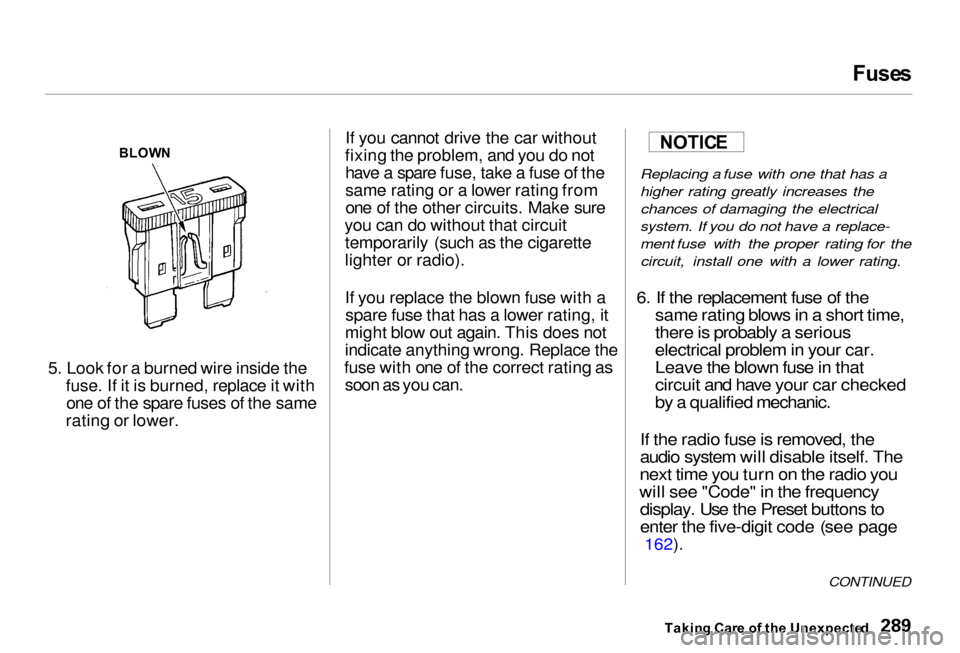
Fuse
s
5. Look for a burned wire inside the fuse. If it is burned, replace it withone of the spare fuses of the same
rating or lower. If you cannot drive the car without
fixing the problem, and you do not have a spare fuse, take a fuse of the
same rating or a lower rating from
one of the other circuits. Make sure
you can do without that circuit temporarily (such as the cigarette
lighter or radio).
If you replace the blown fuse with aspare fuse that has a lowe r rating, it
might blo
w out again. This does not
indicate anything wrong. Replace the
fuse with one of the correct rating as soon as you can.
Replacing a fuse with one that has a
higher rating greatly increases the
chances of damaging the electrical
system. If you do not have a replace-
ment fuse with the proper rating for the circuit, install one with a lower rating.
6. If the replacement fuse of the same rating blows in a short time,
there is probably a serious
electrical proble
m in your car.
Leave the
blown fuse in that
circuit and have your car checked
b
y a
qualified mechanic.
If th
e radio fuse is removed, the
audio system will disable itself. The
next time you turn on the radio you
will see "Code" i
n the frequency
display. Us
e the Preset buttons to
enter the five-digit code (see page
162).
Takin g Car e o f th e Unexpecte d
BLOW
N
CONTINUED
NOTIC
E